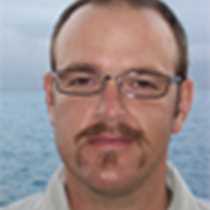Chinese Hat & Santiago Islands
Contrast prevails as we arrive at Chinese Hat Island and the Bainbridge Rocks. During this expedition we started with visits to the oldest islands with their extensive biodiversity, and now we encounter black basalt with life arriving and trying to take hold. At anchor we are surrounded by the Bainbridge Rocks that appear to be volcanic cones that were dropped from the sky. A pre-breakfast swim from the ship with cannonball splashes warms us up for what lies ahead.
Santiago Island with its fresh lava and Chinese Hat are separated by a very narrow channel, and this is where we begin to explore by taking to the water. All are surprised at the amount of life underwater in comparison with the land area as we encountered a white tipped reef shark almost immediately. Details are small with the occasional White Sea urchin and the endemic Red Sun Star until we come upon a marine iguana feeding underwater. Marine reptiles are not something out of the ordinary barring the marine iguana being the only iguana species to dive and forage in the ocean however when we come across a Galápagos penguin swimming next to the iguana we appear to be in another world. As the water becomes shallower the wildlife gets closer with a marbled stingray, tiger snake eel, and chocolate chip sea star standing out. A wonderful snorkel finishes with a penguin staring us eye to eye and then fleeting off to forage. A small group that decided to land at Chinese Hat had the whole island to themselves being surrounded by sheer raw beauty and just the sea lions and oystercatchers to converse with. Jimmy, our well-loved barman, greets us as we return with freshly baked brownies and lemonade to help us recuperate our energy. Captain Pablo weighs anchor and we start navigation towards one of the Bainbridge Rocks. We arrive to a cliff area and skirt the coast until we are able to peer inside this eroded tuff cone and are delighted to find Greater Flamingos in the brackish pond inside. This was a wonderful closing to our morning as we navigate to Sullivan Bay at Santiago Island.
Sullivan Bay was created a bit over 100 years ago when one of the prominent shield volcanoes released several square kilometers of basalt increasing the land area of Santiago. The afternoon brings us in contact with the new and desolate lava flow as we land and hike inland. All is not as it seems as we start to investigate the various formations here. Hornitos popped up on the flow as water vapor and gas were released. The contrast of colors is impressive from the bright red of the iron content to the metallic sheen of the magnesium. Life has arrived here as we find the small endemic pioneer plant, Crocker’s mollugo with its minor flower hardly notable. Lava cactus sticks out from the cracks and crevasses as it breaks down the minerals and makes soil with its eventual decomposition. Coming to the edge of the new flow we find the casts of Opuntia prickly pear cacti trees that were plunged over and vaporized during the volcanic eruption leaving behind their form forever molded in the basalt. Returning to our ship we all ponder and revel in the knowledge that we are witnessing the beginning of life and change at its most basic level laid before us in these enchanted islands.




